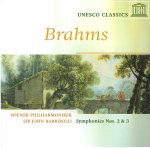John Barbirolli’s Vienna Philharmonic Brahms Second and Third symphonies date from the mid-1960s. At the start of the D major Second symphony cellos and basses sound too loud, but that’s probably a fault of the recording itself. Later, Barbirolli sculpts the first big climax of the exposition passionately, but the recording can’t effectively contain the fortissimo without distortion, and there’s a metallic quality to high-register violins throughout that can be annoying. Again, probably due to the engineering, the cellos and violas are still too loud as they announce the second subject. The Vienna cellos are superb in the main theme of the Adagio, and Barbirolli (a cellist himself) achieves the dark, weighty tone the passage ideally needs, letting the phrase peak and trough in vocal style. There’s a well-managed transition after the faster section mid-way through the third movement, where Barbirolli skillfully eases back to Tempo I, but some listeners won’t like the nasal tone of the first oboe in the main theme. The finale is exciting, taken at quite a fast basic tempo, but the already bright-sounding transfer doesn’t contain dynamic extremes. The final section (from the trombones’ entry) is magnificently done.
Barbirolli’s account of Symphony No. 3 also is impressive, with a highly effective opening (rising wind chords leading to the first colossal statement of the symphony’s motto theme) that’s immediately gripping. Later in the first movement the tension doesn’t slacken, and again the recording shows its weaknesses at climaxes. Cellos are again superb in the Andante, but the recording doesn’t let the sensitive interplay between lower strings, clarinets, and bassoons register properly, and tape hiss is distracting at the start of the finale. Interpretively these are distiguished accounts and certainly are worth hearing if you’re a Barbirolli devotee, in which case you’ll probably accept sonic limitations willingly.
































